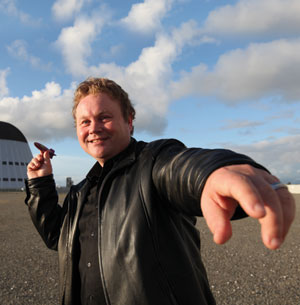Cape Reinga is the point at which the Tasman Sea and the Pacific Ocean meet. It is the northernmost tip of New Zealand. There are only two ways to get there: a bus or something else. This is how Brandon Plaster describes the 140-mile journey from Paihia to Cape Reinga. The one he embarked on at the tail end of his time studying abroad. The one that started on June 6 at 6:23am. He carried a 45-pound backpack on the trek.
Brandon Plaster is telling me the story of his journey to Cape Reinga, which, in the haze of initial introductions, seems like the non sequitur to end all non sequiturs. But as the story unfolds, it tells me everything I need to know about the person sitting in front of me and the very project that makes him worth sitting down with. About the sort of person one has to be when embarking on something bigger than themselves.
He sports a quintessential jewfro (though whether or not he is Jewish I couldn’t tell you, because it is rude to ask such things). He orders a vanilla latte. We sit down outside.
I ask him if it’s true that he’s going to the moon, and he can’t quite answer immediately, because he’s seen a hummingbird behind me, and honestly where does one go after that?
Dressed in a warm black fleece and light-washed jeans, with enough tears around his flip-flop-adorned ankles to let you know that he has indeed been wearing the jeans for a while, Brandon is, at that moment, a most singular figure, if not an unexpected one, with whom to assess and digest the next giant leap in space exploration. And he’s sitting here telling me a story that begins with a 45-pound backpack and will end with cologne, a car crash and a fork in the road.
At 22, Brandon Plaster finds himself part of a project that could, in theory, redefine how we view not only lunar research and space travel but also the entire concept of government-funded vs. privately financed projects. With recent talk of lunar colonization flooding the Republican primary season, the moon suddenly seems to matter again.
And where the buttoned-up Houston control engineer of yesteryear, with his black-framed, horn-rimmed glasses and pocket protector firmly in place, pulled off one of the greatest human accomplishments of the 20th century, the next great American hero may look nothing like them. In fact, they may be enamored by a hummingbird. They may just look like Brandon.
If successful, Brandon and his cohorts wouldn’t just be revitalizing America’s lunar relationship; they could also help make the dream of clean energy an actual reality. They could finally bring about the seemingly eons-touted concept of commercial flights to the nether regions of space. And in doing so could make America a dominant presence in space exploration and innovation—again.
But for now, there is a hummingbird behind me, and that, apparently, is some truly crazy shit.
The company that Brandon finds himself in (or, more accurately, that found Brandon) is Moon Express, currently located in Mountain View but due to move to a new location in Silicon Valley by the end of this spring 2012.
MoonEx, as it is often called, is one of 26 companies currently vying to win the Google Lunar X PRIZE (GLXP) competition. (Seven have withdrawn since the competition’s announcement in 2007.)
The GLXP is organized by the X PRIZE foundation and sponsored by Google, and carries with it a secondary moniker—”Moon 2.0″—which speaks volumes about the intention of both its participants and the project.
The competition itself comes with a fairly specific set of rules: Teams win $20 million if they are the first to land a robot on the moon and have it travel 500 meters and transmit data and high-definition images back to Earth.




